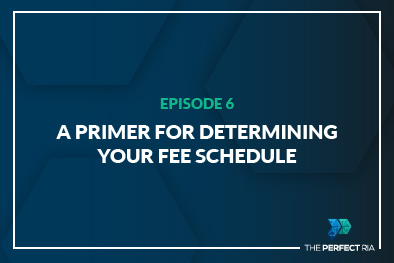Matthew Jarvis and Micah Shilanski show how simplicity, value structures, and confidence trump all when it comes to determining what to charge clients.
From the Perfect RIA studio comes this valuable lesson in determining fee schedules. In thirty odd minutes, Matthew Jarvis and Micah Shilanski team up to provide the what, when, why, and where of charging clients. If you tune into this episode, you will experience a detailed talk about if you should raise your rates or not to clients who have been with you for years. There’s a lot of discussion about value structures and how these factor into the amount that you should charge. And also, a lot is said about confidence and goals and how this will ultimately raise the ceiling for your rates. In brief, the value of this talk is in its ability for helping you find how valuable you need to be to achieve your goals for your firm. And once you find the right price, one that calculates the amount of growth you want your business to experience, then you need to put your foot down and stick to it. There isn’t any wiggle room at all. The moment you start negotiating is the moment your clients stop taking you as seriously as they could. Matt and Micah remind you to stick to your price and project your value by the rates you charge.
Very briefly, this post will provide a surface value conspectus of the themes that are laid out in this episode by hosts Matt and Micah. To start, simplification is key when thinking about what prices should be. Micah says that you should get in the practice of writing out your whole fee schedule on just a single post-it note. It should be that simple and brief. Any longer and you run the risk of being swayed this way and that way instead of being firm and secure in a few simple, concrete facets of your plan. Another aspect of simplifying your pricing plan is to not worry about what competitors are charging, just charge what you honestly think your work is worth. Be realistic, be consistent, and be simple.
To continue with the bullet-points summary of this episode, our hosts state that determining a cost-value structure is an extremely smart thing to do because your prices will reflect how valuable your services are. Micah states that when factoring in growth and revenue for your business, you will have to charge your clients according to whatever your goals are and how valuable you perceive yourself to be. He states that you might need to “charge seventy-five hundred dollars to financial planning theory. Maybe that’s how you set your minimums. That’s what you would need to bring in, in order to get to your goals. You have to justify that fee with the value in which you bring to the table.” Micah then goes further than that and mathematically breaks down how to make these cost-value determinations: “Here’s the simple math, you want to grow by one hundred and fifty thousand dollars in revenue, from three fifty to five hundred and you want to bring on twenty new clients. That means you need to charge seventy-five hundred dollars as a minimum for every new client which you bring on this next year. That’s the math that you need to have.” And because math is much easier to make sense of when visually represented, Micah and Matt provide a diagram of this calculation here:
Now, it may take a lot of time and experience to provide realistic rates for your clients, but overall, if you provide top-tier services then why would you charge an entry-level rate? What you charge shows your clients how much value you place in yourself. And in line with this, both speakers reminds us that the prices we charge should also reflect the goals we have as entrepreneurs, advisors, investors, etc. The cost-value structure should be adjusted in line with how much growth is expected or desired for your enterprise. If you want to provide first-class services, you may only attract a wealthier, niche clientele, but at least you won’t sacrifice your confidence in yourself. And that brings us to the last point: be confident and stick to your business plan.
Without both confidence and a business plan, clients who ask you questions might catch you off guard. If you hesitate or betray the fact that you haven’t thought everything through thoroughly, you can pretty much kiss that client bye. Plan everything out, and have enough confidence in yourself to stick to your plan and believe in the value you bring to your customers.
And that is all that needs to be said here. To learn more about this subject and hear multiple accounts from the lives of both Matt and Micah, listen to this episode of the Perfect RIA and hear it from the men themselves. If you would like to cut out the middlemen and just read the transcript, we have provided it below for your convenience.









